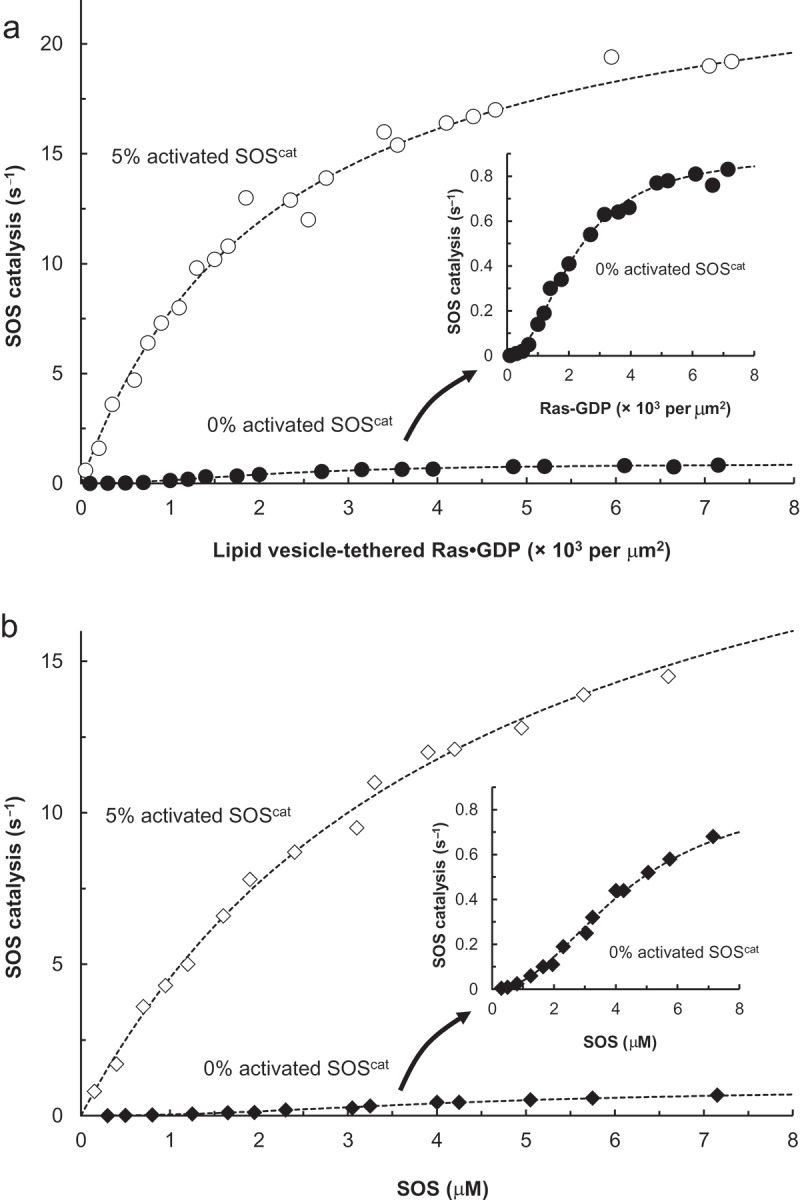Figure 8.

SOS autoactivation-mediated SOS cooperativity. SOScat titration with the lipid vesicle-tethered wt Ras•GDP* and reverse titration were performed in the presence of excess GTP. When necessary, we used 5% activated SOScat instead of 0% activated SOScat. Unlike with 0% activated SOS, the partly activated SOS (e.g. 5% activated SOS, see the Materials and Methods section for its preparation) initiates SOS autoactivation without wt Ras•GTP, the reaction initiator. (a). 0% or 5% activated SOScat (1 μM) was titrated with various densities of the lipid vesicle-tethered Ras•GDP* (0–8.0 × 103 Ras•GDP molecules/μm2) in the presence of excess free GTP (1 mM). The resultant SOS-mediated Ras nucleotide exchange of each titration was monitored as indicated in Figure 5. GraphPad Prism software was used to calculate and plot the apparent kcat values of each titration that reflected Ras•GTP production (s−1) against Ras•GDP (molecules/μm2) and fit them to a hyperbolic saturation or a Hill plot. A hyperbolic saturation curve was used to determine the Km of SOScat for the lipid vesicle-tethered as 2.4 × 103 molecules/μm.2 The Hill coefficient and half-maximal effective substrate concentration (K0.5) values of the hysteretic saturation curvature titration were, respectively, 2.1 and 0.9 × 103 molecules/μm.2 (b). The lipid vesicle-tethered Ras•GDP* (1.0 × 103 Ras•GDP molecules/μm2) was titrated with various amounts of 0% or 5% activated SOScat (0–10 μM) in the presence of excess free GTP (1 mM); the corresponding apparent kcat (s−1) values were calculated as indicated in A and plotted against SOScat (μM). GraphPad Prism software was also used to fit the titration plots to a hyperbolic saturation or a Hill plot. The SOS concentration needed to yield one half of the maximal velocity for the catalysis of the lipid vesicle-tethered Ras•GDP* (1.0 × 103 Ras•GDP molecules/μm2) was determined to be 1.9 μM. The hyperbolic saturation curvature was used for this determination. Intriguingly, the estimated Hill coefficient of the hysteretic saturation curvature titration of B also converges to 2.1. Insets: Expansions of the hysteretic saturation curvature in both A and B are shown
